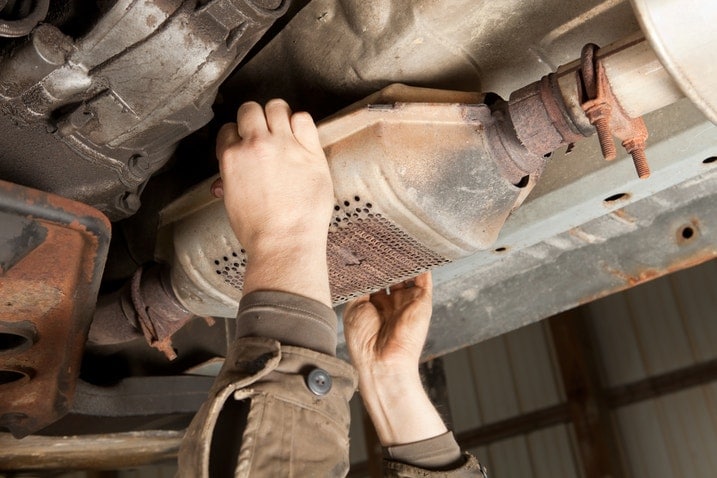Photo: BanksPhotos | Getty Images
Vehicles with combustion engines have a catalytic converter as part of their exhaust systems. This component plays an important role in preventing harmful emissions from the exhaust. These components contain precious metals. Because of their value, theft is a common problem — thieves cut the converter out of the exhaust system to sell it for those metals. These thefts leave some people wondering if they need a catalytic converter in their engine. Below, we explore the role of catalytic converters, how they work, and why they're necessary.
What is a catalytic converter and what does it do?
A catalytic converter is a device that acts like a filter. Exhaust gases are pumped through it and pass over a honeycomb of precious metals that act as catalysts (hence the word "catalytic") and cause reactions that break down unwanted chemicals before the exhaust gases are released into the air.
There are two varieties of catalytic converters:
Two-way: Common in older vehicles, these convert carbon monoxide into carbon dioxide and unburned hydrocarbons into water and carbon dioxide.
Three-way: More modern vehicles have a three-way converter, which performs the reactions described above and converts nitrogen oxide into nitrogen and oxygen.
Can you drive without a catalytic converter?
It's possible to drive a car without a catalytic converter. However, this is one of those situations where the adage "Just because you can doesn't mean you should" definitely applies. Driving without a catalytic converter could put the health and safety of your passengers at risk. It could also damage your car and land you in legal hot water.
Legal requirements for catalytic converters
Federal law says if your vehicle was equipped with a catalytic converter when it was made, you aren't allowed to remove it. Individual states set their own penalties and methods of enforcement, and these vary from lax to incredibly proactive and strict. Some states, including California, Colorado and New York, have strict emission requirements, so if your catalytic converter breaks, you need to install a new one that's CARB-compliant — or, in other words, one that complies with the standards of the California Air Resources Board.
What happens if you remove or bypass a catalytic converter?
If your catalytic converter has been stolen or you bypass it because it's been having problems, your vehicle will still work. However, without a converter, your car lets out harmful emissions, including carbon monoxide and nitrogen oxides. These will be released directly under your vehicle, where they could potentially enter the cabin and make you or your passengers sick.
You may also notice the engine is noisier, and the vehicle may feel sluggish. Running the car this way could reduce fuel efficiency and even damage some components. Rather than trying to drive a car with a missing catalytic converter, it's best to have it towed to a garage for repairs.
Common reasons for catalytic converter failure
For the most part, catalytic converters are durable parts that can be expected to last for about 10 years or even longer if you take good care of your car or truck. Over time, they can become clogged or damaged, especially if you've put the wrong fuel or low-quality fuel into your vehicle.
Catalytic converter failures typically fall into one of a handful of categories:
Structural damage (such as corrosion or damage from road debris)
Overheating
Clogging
Contamination from fuel additives or oil
Warning signs of a failing catalytic converter
Catalytic converter issues aren't always obvious. They can manifest themselves in several ways, including:
The check engine light comes on.
Fuel consumption increases for no obvious reason.
Strange rattles come from the engine.
Your car experiences sluggish acceleration.
The engine misfires.
There's foul-smelling or darker-than-usual exhaust.
Most newer vehicles have multiple sensors that keep track of the performance of the engine and alert you if your catalytic converter is no longer operating within acceptable parameters. Even if your car is otherwise running well, don't ignore a check engine light. Get your catalytic converter inspected. Catching issues early could prevent more costly repairs in the future.
How much does it cost to replace a failed catalytic converter?
You can expect to pay between $1,000 and $3,000 for a replacement catalytic converter, depending on the make and model of your vehicle. Original equipment manufacturer or OEM catalytic converters usually cost more than aftermarket ones but often last longer.
If you're considering an aftermarket converter, make sure it complies with any relevant emissions requirements in your state.
How to care for a catalytic converter
You can extend the life of your catalytic converter by taking good care of it and practicing sensible driving habits.
Fix mechanical problems promptly. Small problems can cause more damage than you think, and a misfiring engine could lead to carbon buildup on the honeycomb surface inside the catalytic converter, preventing it from doing its job.
Drive at a moderate speed when possible. Running at high speeds for a long time can accelerate existing damage to a converter.
Avoid towing heavy trailers or overloading the vehicle. Both can overwork the engine.
Use high-quality gasoline brands. Cheaper brands can shorten the life of a catalytic converter dramatically due to impurities in the fuel.
Follow the manufacturer's recommended oil-changing schedule, and choose high-quality oils.
Catalytic converters play an important role in protecting the environment and keeping your engine running smoothly. They may cost thousands of dollars to replace, but it's a worthwhile investment. If you're having issues with your vehicle, whether it's rattling noises or a check engine light, take a trip to a garage as soon as possible for peace of mind.


 by
by  edited by
edited by 


